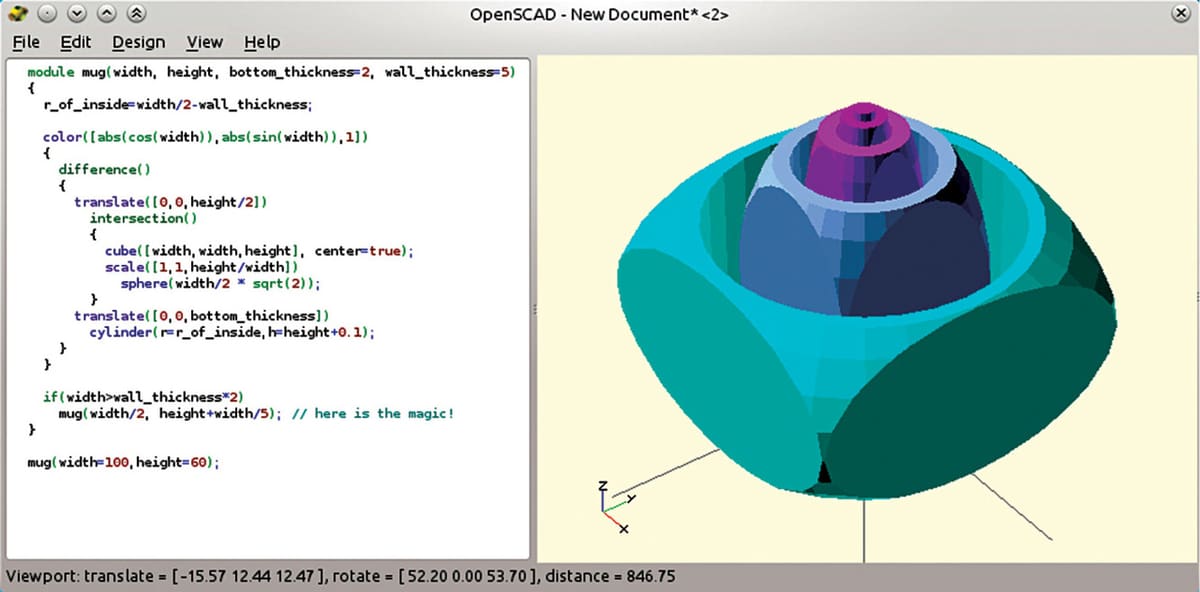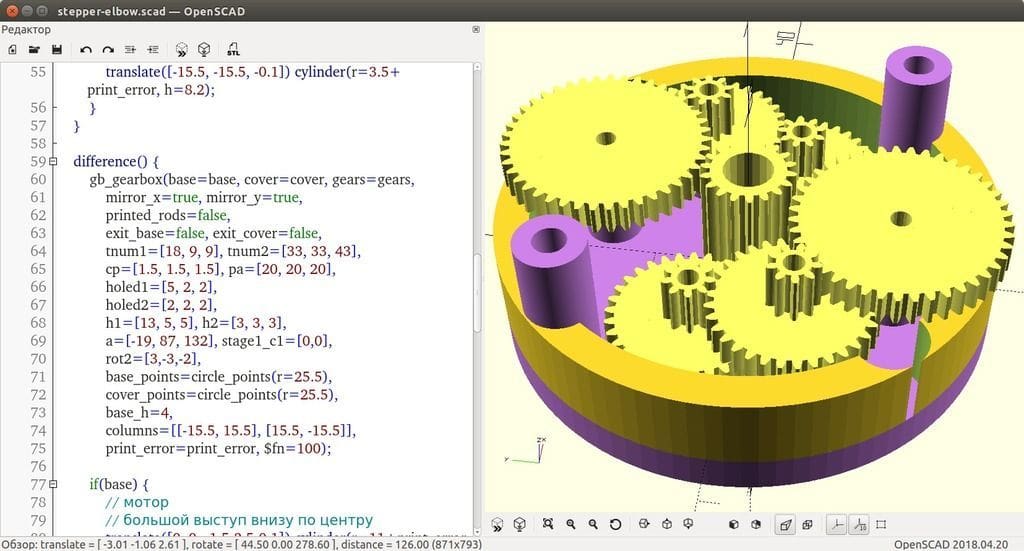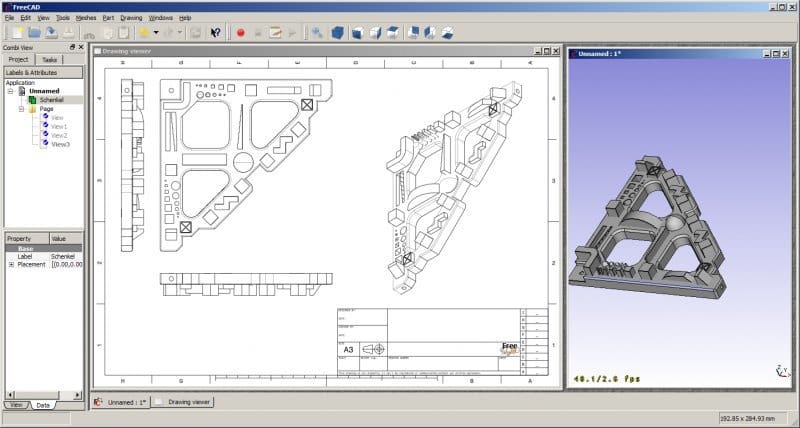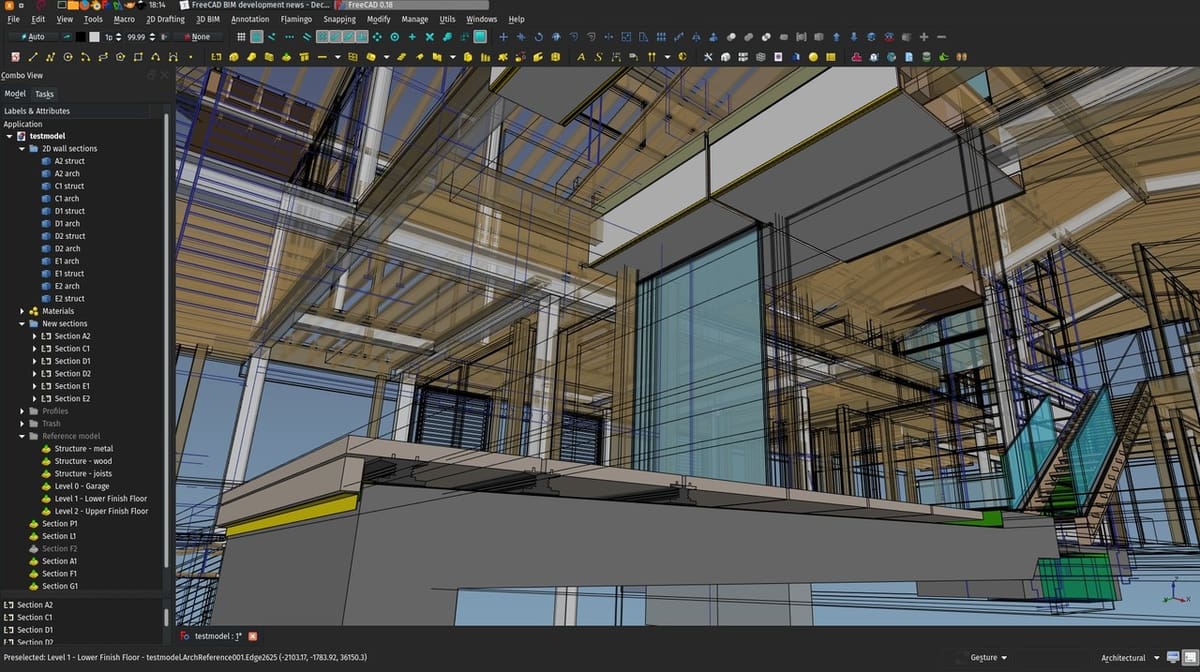To Code or Not to Code
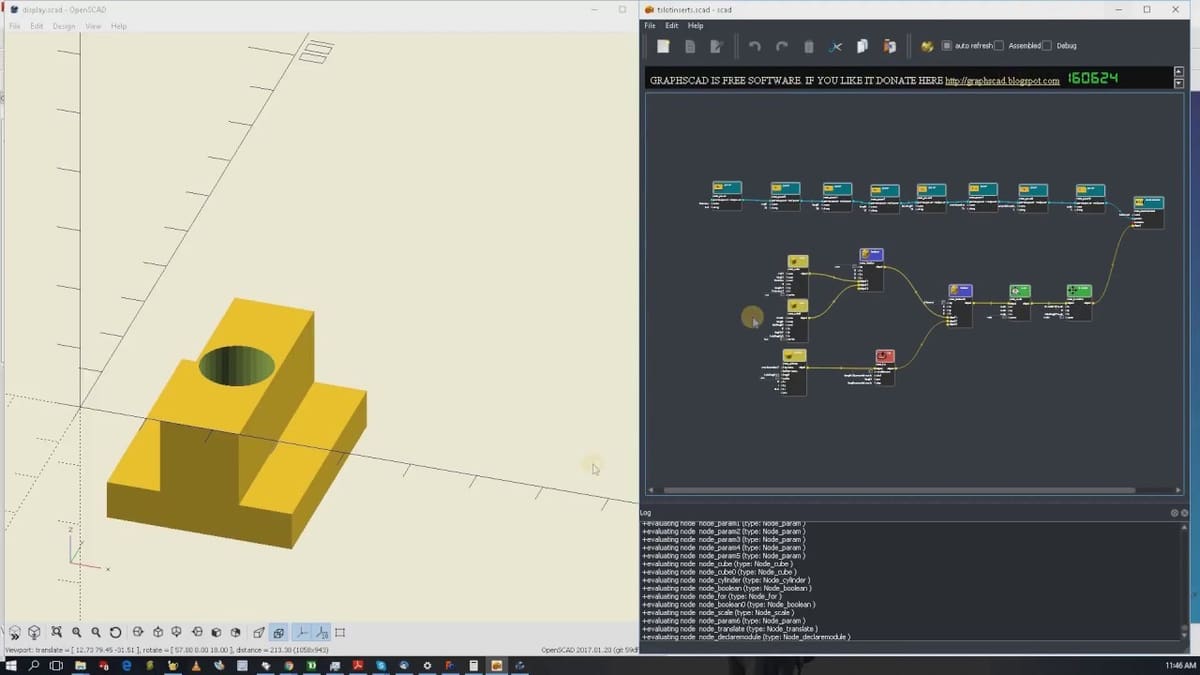
OpenSCAD and FreeCAD are both parametric computer-aided design (CAD) programs used for 2D and 3D modeling. Going further, they’re both open-source and free for anyone to download. Users can see, study, and improve their code, whether just for themselves or for the community as a whole.
Although the two platforms take you to essentially the same 3D modeling destination, they take different ways to get there. OpenSCAD is a script-only based modeler and uses its own description language. That means its UI only shows code and doesn’t have literal representations of your object. FreeCAD, on the other hand, uses a more traditional CAD approach, with you building your object by directly manipulating the visual model.
These and further aspects lend each of the two programs unique strengths and weaknesses. Let’s take a look a the details in order to determine what they are.
OpenSCAD
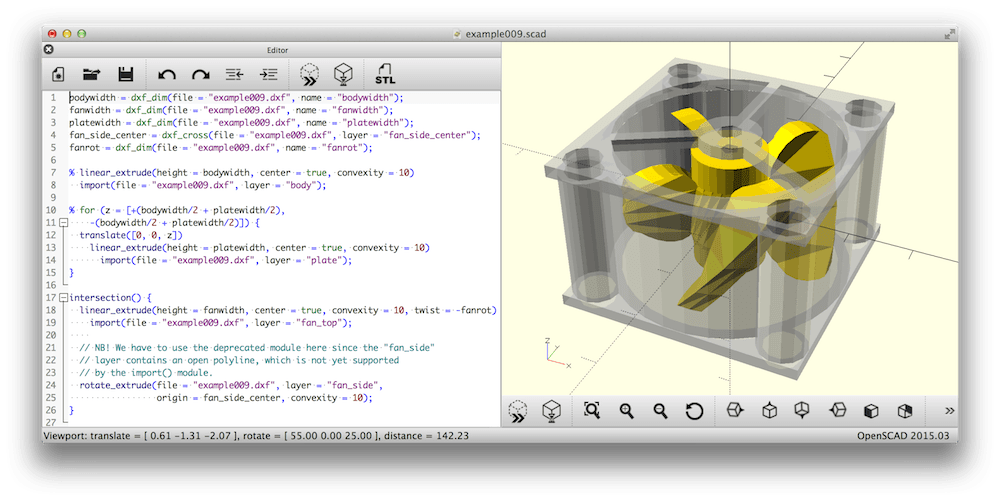
OpenSCAD uses constructive solid geometry to create CAD objects. As we mentioned above, it does this solely through manipulating the code of its own descriptive language. That’s why it’s advertised as a programmer-oriented solid-modeling tool; although anyone can use it, its interface will be most familiar to those who work with code.
Through OpenSCAD’s script, users indicate what basic geometric shapes (for example a sphere or a cone) to use, the parameters of those shapes, and how those shapes relate to each other. Together, all those factors add up to the same type of 2D or 3D model you can make with any CAD software.
What sets OpenSCAD apart from other tools is that you’ll be building through word commands rather than pictures.
As its name implies, OpenSCAD is not only free but also open-sourced. This fact, coupled with its code-forward UI, makes it a great CAD program for those who want to experiment with the inner workings of their modeling software.
- Company: OpenSCAD
- License: GNU General Public License, Version 2
- Cost: Free
- Where to get it: OpenSCAD website
- Community: OpenSCAD forums, mailing list, and IRC channel
- Best for: Functional part modeling
Pros
OpenSCAD may seem like a specialized program, but community members swear by its reliability and ease. Its code-based CAD construction gives you access to fine-tuning only possible with the precision of numbers.
- Variables are modifiable. Because OpenSCAD reads your design script and compiles your object from that instead of direct interaction with the object design, it’s very easy to change the parameters and other variables any time you want. That’s because all you have to do is find the line of code that pertains to the feature you want to change; alter the number or relative measurement instead of trying to visually pinpoint where you went wrong on an interactive object several steps ago.
- Algorithms enable complicated designs. This level of detail control gives you the precision needed for designs and models that have many more points of reference than those created visually.
- User-made designs are easily accessible. OpenSCAD has all its own program code available for use and manipulation, so if you don’t see a feature you’d like to have, chances are someone in the OpenSCAD community has built it or something like it. You can also code it yourself and share with your fellow users!
Cons
Although it lives up to its promise of accessibility and detail, OpenSCAD does have a few limitations that are worth mentioning to potential users. Beyond the initial novelty of its UI, OpenSCAD isn’t equipped with the testing features you may want for industrial designs.
- Coding requires additional learning. Users praise OpenSCAD’s friendly interface, saying that, even if you don’t know how to code, it’s easy to get started. However, when you consider how different this approach is to other CAD software out there – many of which feature graphical interfaces – OpenSCAD will require some major getting used to.
- Preview tools are basic. OpenSCAD doesn’t keep you in the dark about how your design looks as you code. Its preview window shows you the picture of your design as you go along. However, beyond rudimentary animation through stitching several frames together, OpenSCAD doesn’t offer simulation features for your design. You can’t test any outside forces on your model, nor can you see how it will hold up under the movement of its own pressures. That is crucial to several types of CAD modeling outcomes, such as part manufacturing, so be aware of OpenSCAD’s limitations before you commit to it.
FreeCAD
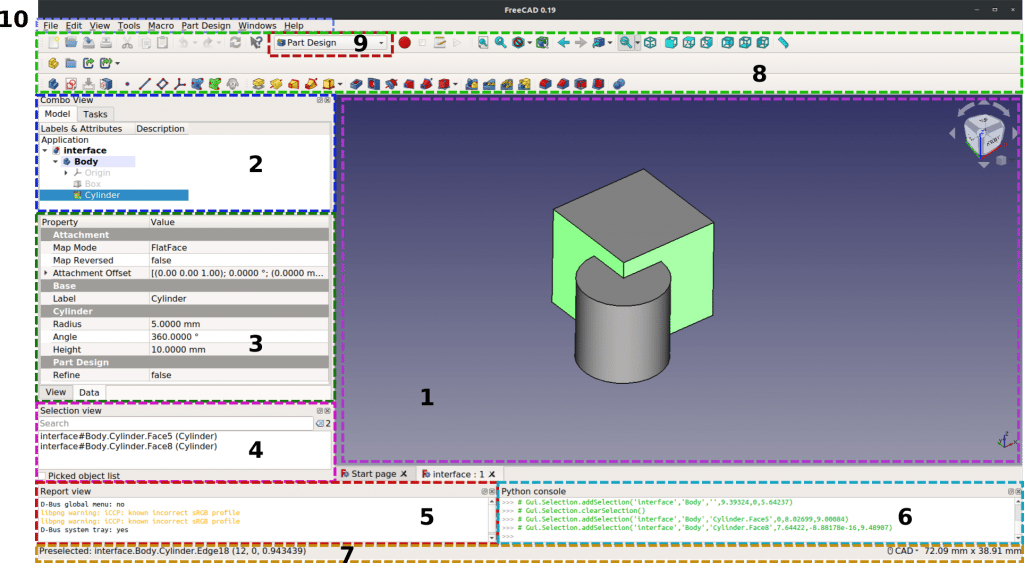
Since FreeCAD has a more traditional user interface structure, it’s considered a CAD program for users who are more artistic, and by that we mean basically anyone who isn’t comfortable building an object through lines of code.
FreeCAD is classified as a parametric 3D CAD modeler. It also supports building information modeling, which means it has architectural and other structure-based engineering tools within its CAD capabilities. FreeCAD uses finite element analysis to support its simulation features in a single UI.
FreeCAD is also, not surprisingly, free and open-sourced, so those so inclined can still get a look at its software building blocks and tweak them to their heart’s content.
- Company: FreeCAD
- License: GNU General Public License, Version 2 for code and Creative Commons Attribution 3.0 for documentation
- Cost: Free
- Where to get it: FreeCAD website
- Community: FreeCAD forums, IRC channel, and social media groups
- Best for: General 2D and 3D modeling
Pros
FreeCAD is fast becoming a staple no-cost entry point into traditional CAD design. Its open-source code, like OpenSCAD’s, is also lending itself to modifications and improvements both official and user-created.
- Designing is simple. FreeCAD’s parametric model lets you take advantage of numerous features, like the ability to view previous drafts and use its 3D viewer, making your design process easier.
- Functionality is flexible. Built on a modular setup, FreeCAD is customizable with features that are directly designed for your specific projects. Even more, functions are accessible through numerous official and user-created plug-ins. Once you learn the basics, you can build FreeCAD into the exact CAD program of your dreams.
- Specialized modules cater to specific CAD needs. FreeCAD offers a variety of modules specialized for CAD-dependent industries, which have their own standards and features. You don’t have to add those from scratch when you’re working in, say, architecture, saving you time and keeping you compliant with industry standards.
Cons
As a non-profit labor of love, FreeCAD has a few quirks that come up as you maximize its usability. Some you can get around with advice from the community and documentation, but some are simply built in to the way FreeCAD works.
- The learning curve is steep. Although FreeCAD’s UI does present a traditional functionality familiar to CAD veterans, users say it still presents a challenge to navigate. Even with the community’s wealth of advice and tutorials, it can be overwhelming.
- The CAD kernel is buggy. The one aspect that you can’t change in FreeCAD is its CAD kernel. Open Cascade apparently has a few bugs within it that FreeCAD’s troubleshooters can’t fix, and that’s a major issue if you come across one during a major design. Community users map out what they can and offer workarounds, but they may not solve your specific problem.
- Complex designs slow performance. Users who have pushed FreeCAD to its design limits have noticed a bit of a lag once an object reaches a certain level of complexity. This is apparently because it runs single-threaded, which means it executes just one command at a time. The good news is that FreeCAD doesn’t crash or freeze at these points, but it does start taking longer (up to a minute according to one user) for commands to be completed.
Final Thoughts
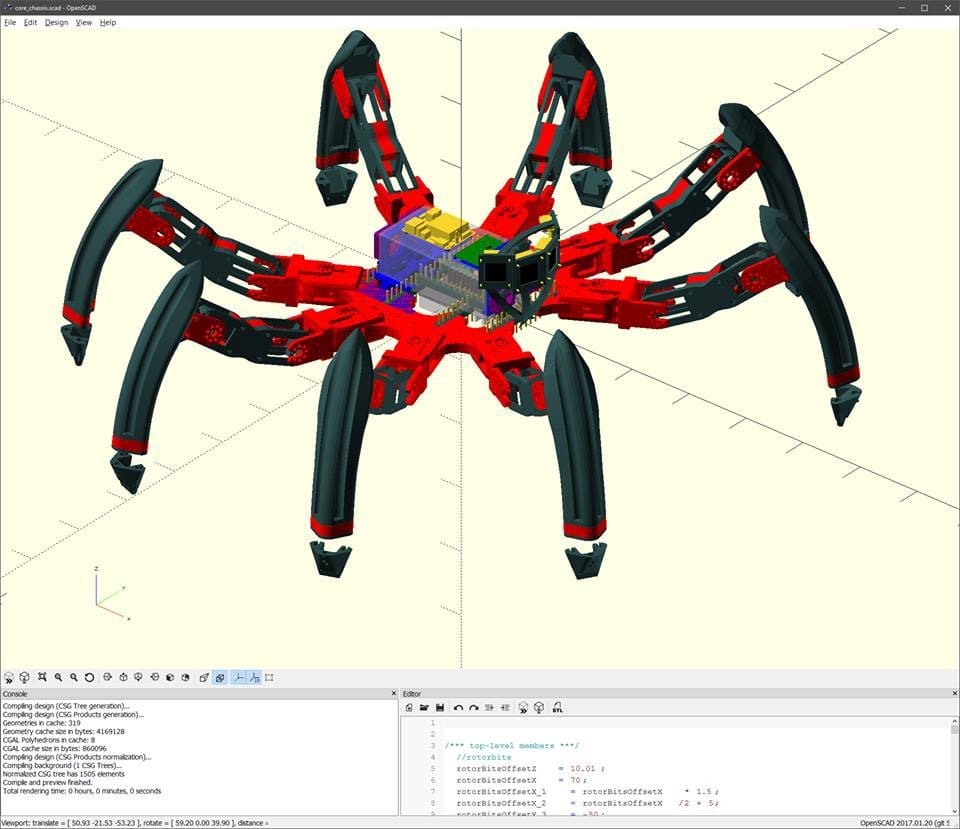
Comparing OpenSCAD and FreeCAD head-to-head is complicated because their nuts-and-bolts operations are so different. But it all comes down to which CAD approach suits you best.
We like FreeCAD because of its wider application. It has more integrated features that let you visually take your designs further, and although its UI takes a little getting used to, it’s customizable and translatable to those who want to move on to other traditional CAD programs in the future.
If you’re a programmer, OpenSCAD will feel more intuitive to you from the start, and it’s worth learning if your designs need the algorithmic level of detail that its UI offers. For engineers and others searching for a free alternative to traditional CAD programs that they’ve already trained on, FreeCAD is better because it continues to build your skillset.
(Lead image source: Plos)
License: The text of "OpenSCAD vs FreeCAD: The Differences" by All3DP is licensed under a Creative Commons Attribution 4.0 International License.

